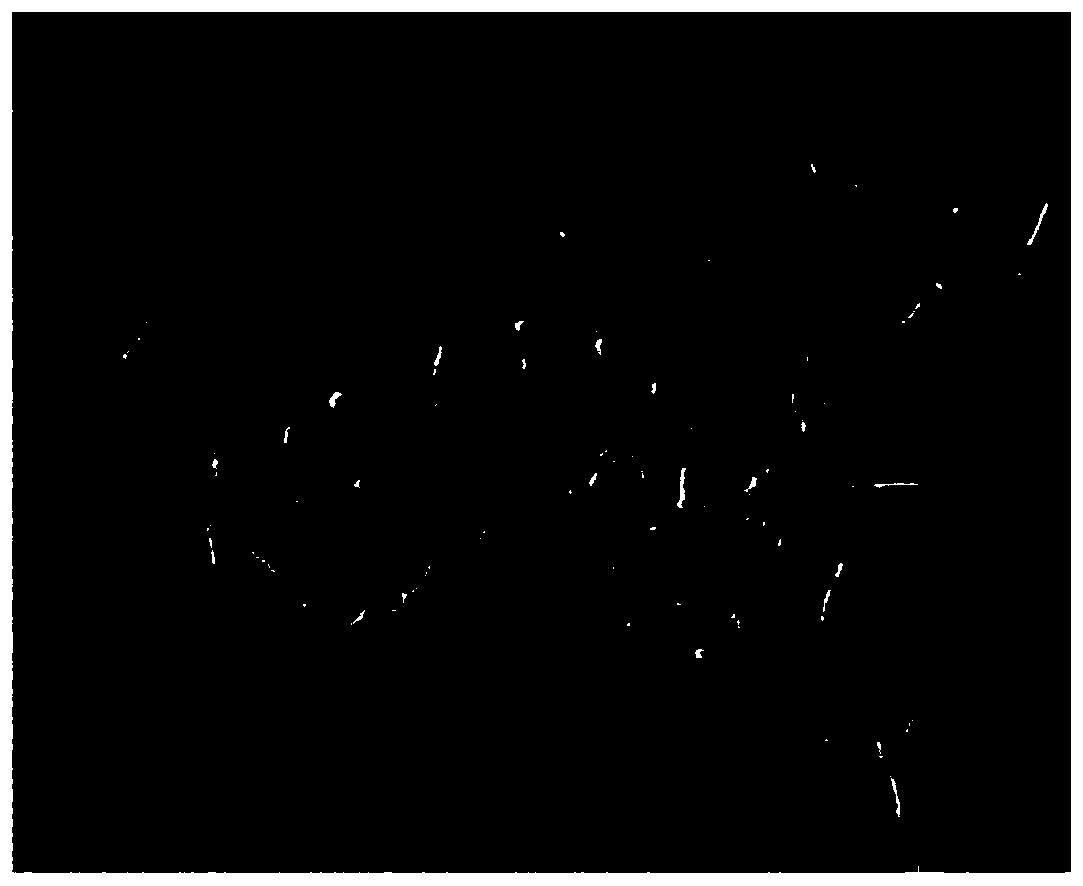Fluorescence ratio type spectral analysis method for detecting carcinoembryonic antigen, and application thereof
A carcinoembryonic antigen and spectral analysis technology, which is applied in the direction of fluorescence/phosphorescence, material analysis and material analysis through optical means, can solve problems such as interference of luminous intensity, achieve high sensitivity, eliminate background interference, improve accuracy and The effect of stability
- Summary
- Abstract
- Description
- Claims
- Application Information
AI Technical Summary
Problems solved by technology
Method used
Image
Examples
Embodiment 1
[0036] A fluorescence ratio spectral analysis method for detecting carcinoembryonic antigen, the analysis method includes the following steps:
[0037] (1) Synthesis of ZGO:Sr NRs and surface CEA-Apta modification:
[0038] ①Add 0.5g Zn(NO 3 ) 2 , 0.0008g Sr(NO 3 ) 2 Add the solid to 8mL ultrapure water, mix and stir evenly, and add 200μL of concentrated HNO with a concentration of 14mol / L 3 After mixing uniformly, a colorless and transparent solution 1 is formed; then the concentration of 1mL is 0.02g / mL Na 2 GeO 3 The solution was added dropwise to the above colorless and transparent solution 1, and the pH value of the solution was adjusted to 7 by adding ammonia water, and the solution gradually changed from clear to white and turbid. Stir continuously and quickly at room temperature for 1 hour, then transfer it to a PTFE hydrothermal reactor and heat it up to 200°C for 4 hours at a heating rate of 2°C / min. After cooling to room temperature, collect the lower sediment by centrifu...
Embodiment 2
[0045] A fluorescence ratio spectral analysis method for detecting carcinoembryonic antigen, the analysis method includes the following steps:
[0046] (1) Synthesis of ZGO:Sr NRs and CEA-Apta modification:
[0047] ①Add 0.6g Zn(NO 3 ) 2 , 0.001g Sr(NO 3 ) 2 Add the solids to 10mL of ultrapure water, mix and stir evenly, and add 300μL of concentrated HNO with a concentration of 15mol / L 3 After mixing uniformly, a colorless and transparent solution 1 is formed, and then the 2mL concentration is 0.06g / mL Na 2 GeO 3 The solution was added dropwise to the above colorless and transparent solution 1, and the pH value of the solution was adjusted to 9 by adding ammonia water. The solution gradually changed from clear to white and turbid. Stir continuously at room temperature for 1.5 hours and then transfer it to a PTFE hydrothermal reactor to heat up to 220°C for 5 hours at a heating rate of 3°C / min. After cooling to room temperature, collect the lower sediment by centrifugation for precip...
Embodiment 3
[0055] A fluorescence ratio spectral analysis method for detecting carcinoembryonic antigen, the analysis method includes the following steps:
[0056] (1) Synthesis of ZGO:Sr NRs and CEA-Apta modification:
[0057] ①Add 0.7g Zn(NO 3 ) 2 ,0.0012g Sr(NO 3 ) 2 Add the solids to 12mL of ultrapure water, mix and stir evenly, and add 400μL of 16mol / L concentrated HNO 3 After mixing uniformly, a colorless and transparent solution 1 is formed, and then 3mL is 0.1g / mL Na 2 GeO 3 The solution was added dropwise to the above colorless and transparent solution 1, and the pH value of the solution was adjusted to 11 by adding ammonia water. The solution gradually changed from clear to white and turbid. Stir continuously and rapidly at room temperature for 2 hours, then transfer it to a polytetrafluoroethylene hydrothermal reactor and heat up to 240°C for 6 hours at a heating rate of 4°C / min. After cooling to room temperature, the lower sediment was collected by centrifugation, the sediment was ...
PUM
| Property | Measurement | Unit |
|---|---|---|
| concentration | aaaaa | aaaaa |
Abstract
Description
Claims
Application Information
 Login to View More
Login to View More - R&D
- Intellectual Property
- Life Sciences
- Materials
- Tech Scout
- Unparalleled Data Quality
- Higher Quality Content
- 60% Fewer Hallucinations
Browse by: Latest US Patents, China's latest patents, Technical Efficacy Thesaurus, Application Domain, Technology Topic, Popular Technical Reports.
© 2025 PatSnap. All rights reserved.Legal|Privacy policy|Modern Slavery Act Transparency Statement|Sitemap|About US| Contact US: help@patsnap.com



